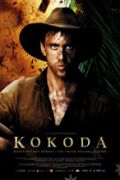
Directed by
Alister Grierson
90 minutes
Rated M
Reviewed by
Sharon Hurst

Kokoda
Synopsis: It is 1942 and the Japanese have landed on the northern coast of Papua New Guinea. The only defence is a group of ill-trained soldiers known as “Chocos” or "chocolate soldiers" who are cut off from supply lines and must battle mud, dysentery, fear, hostile terrain and the enemy, as they make their way back to join the main body of Aussie troops. Camaraderie and fearless Aussie fighting spirit are the order of the day.
I was at once both frustrated and enthralled by this film. The frustration is borne of the fact that I didn’t feel I ever got to know much about the characters.
Based on events that happened near the PNG town of Isavura, where a patrol of about 60 men found themselves cut off from the main troop patrol, for this film the number has been dramatically cut down and features only about seven main characters. Many of the actors will be well known to viewers of popular Australian TV series: Jack Finsterer as Jack, Simon Stone as Max, Jack’s brother, Travis McMahon as Darko, Luke Ford as Burke, Angus Sampson as Dan,Christopher Baker as Bluey and Tom Budge as Johnno. As soldiers, the men are very believable but as characters they are just there, and I found myself desperately wanting some backstory about them. Sure, there is a bit about the brothers, and their love and devotion to each other is touching, but the superficiality of mateship with the others was not enough for me. I also wanted more history of the actual fighting, and of the snobbery from the mainstream Aussie army towards these “chocos” who were largely young and inadequately trained volunteers. There is much of interest to be read on the internet about this, and a better exploration of the issues would have lent more depth to the film. The role of the Papuans or “fuzzies” as they were referred to, helping the troops, could also have been woven more into the story.
Perhaps I’m missing the point, because Kokoda works very well in bringing home to us the gruelling nature of the men's eperience. Masterful cinematography by Jules O'Loughlin captures the extraordinary oppressiveness of the jungle (all shot in Far North Queensland). Stretcher bearers labour through this hell-hole of impossible terrain, with steep, densely vegetated slopes, sudden ravines and everywhere, mud. No sensitivities are spared in showing us the diarrhoea, the seeping lacerated feet, and the general filth.
Powerful use is made of sound – at times just total silence as the soldiers crouch expectantly, guns at the ready, hands trembling. At other moments the sounds of the jungle: insects, drumming rain, thunder, the footfalls of the enemy approaching. And in places a lyrically sad score, underpinning the despair, as the camera pans from above the impenetrable jungle in which our heroes are lost.
Violence, when it comes is swift and sickening, with a couple of very nasty scenes featuring Japanese soldiers doing dastardly deeds. There is absolutely no sense of the enemy as human - they are mainly seen from foot to knee, or as shadowy figures creeping through the jungle with ferny fronds camouflaging their helmets.
Inasmuch as its aim is to show us what the Aussie troops in PNG were made of, Kokoda does it but perhaps it actually needed to be a little longer to give more sense of character.

Want more about this film?


Want something different?




